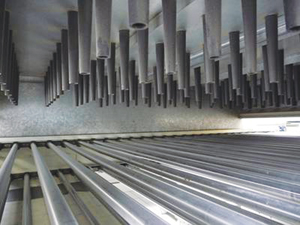Cabinetmakers often finish their cabinets in stain and clear coat or in paint grade. For those who are doing paint grade, remember that applying primer is an important part of the finish process.
Painted cabinets are a significant part of the kitchen/bathroom cabinet market in some areas. However, there is an uncertainty about how to accomplish this finish.
For instance, no self respecting auto body repair person or professional house painter would consider a project done correctly without applying both a primer and a color coat. Yet, I find more and more cabinet finishers who want to skip that first step and go right to applying color. Here are two examples:
Paint Grade Poplar Show-through
Client #1 asked me if he could use a clear lacquer sealer instead of a primer as a base coat under his color coat. Somehow the fact that he had constructed his cabinets from paint-grade poplar didn’t come up in that conversation. This fellow is an experienced builder with years of experience and one I respect. I told him, yes, he could do that. A week later came a follow-up phone call: He complained that he couldn’t achieve a consistent color. He had dark areas, stripes and areas of discoloration. No matter how many coats he put on, color variations remained. There was little doubt that the light and dark spots so characteristic of poplar were telegraphing through the color. He should have primed it.
In a second case, for client #2, I learned from my earlier transgression. I made certain to tell client #2 to apply a primer first, then apply his color coat. With client #2, I got several follow-up calls. The first concerned the fact that he was a quart short and they needed another gallon of color. I mixed it for him. Then came another call. This time client #2 told me the color of the second can didn’t match the first. If there’s a lesson here, it’s this — better to have two quarts too much, than one pint too little!
 Knowing well that I do make an occasional mistake, I asked for wet and dry samples from both cans so that I could be certain that I properly adjusted the color in can #2. When the materials arrived, I put both cans in the mixer and made sure that each was well agitated before I did anything. There wasn’t much left in the first can. While they were in the mixer, I took a look at the dry samples that he sent. Sure enough, one was whiter than the other. The whiter one came from can #1. It looked like he might be right and that I might have made a mistake in tinting.
Knowing well that I do make an occasional mistake, I asked for wet and dry samples from both cans so that I could be certain that I properly adjusted the color in can #2. When the materials arrived, I put both cans in the mixer and made sure that each was well agitated before I did anything. There wasn’t much left in the first can. While they were in the mixer, I took a look at the dry samples that he sent. Sure enough, one was whiter than the other. The whiter one came from can #1. It looked like he might be right and that I might have made a mistake in tinting.
I did spray outs from both cans. I always use a real spray-out card. If you are unfamiliar with these, they are used commonly in the auto body industry where opacity or degree of transparency is crucial. Opacity is easily judged with this card because it is printed in a black and white checkerboard pattern. If you want total opacity, you need to be sure that you can’t see the checkerboard pattern when the coating has cured. No matter what you are looking for in a coating, these cards will reveal a great deal to you. They are available from auto body paint supply houses.
In my case, when both samples were done and had cured overnight, they matched exactly, and there was no trace of black or white. It took a number of coats to achieve this. You would be surprised how much it actually takes to bury those black squares!
So why was it that client #2 came up with different shades of his color coat when both gallons of color matched exactly? He wasn’t priming first. As with client #1, it all comes down to the opacity of the color coat. Often, these coatings are less opaque than we expect. Depending upon the color, opacity issues can be extreme. That’s why you need to use a primer first. And, often the primer coat must be pristine, because it is the white of the primer that helps creates the final color due to the transparency of the color coat.






Have something to say? Share your thoughts with us in the comments below.